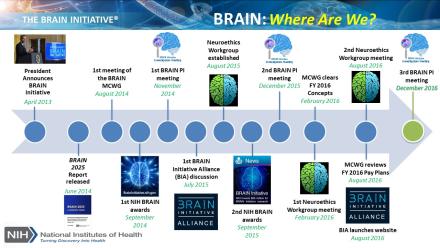
The fifth meeting of the Multi-Council Working Group for the NIH BRAIN Initiative provided an update on scientific advancements, discussed BRAIN-related efforts across federal agencies and non-federal organizations, and cleared concepts for possible new funding opportunities for fiscal year 2017.
On August 2nd, the Multi-Council Working Group (MCWG) for the National Institutes of Health (NIH) Brain Research through Advancing Innovative Neurotechnologies (BRAIN) Initiative® met with directors and staff from the 10 NIH Institutes and Centers supporting the Initiative. The MCWG is an external group of scientific experts that provide oversight of the long-term scientific vision of the Initiative at NIH. Dr. Alan Willard, Acting Deputy Director of the National Institute of Neurological Disorders and Stroke and the MCWG Designated Federal Official, gave welcoming remarks, highlighting that the BRAIN Initiative is integrating science across many fields, including molecular biology, clinical science, neuroscience, engineering, and more. As such, broad expertise is necessary to help maintain the scientific advancements emerging from the Initiative. In addition, the MCWG meeting provided the opportunity to discuss BRAIN-related efforts across federal agencies, private organizations, and around the world.

Drs. Walter Koroshetz and Bruce Cuthbert shared an overview of the NIH component of the BRAIN Initiative. In just two years since NIH issued its first BRAIN awards, those grantees have published over 120 papers, including an exciting study from Dr. Arnold Kriegstein and his colleagues at the University of California, San Francisco, which describes a candidate entry receptor for Zika virus in neural stem cells that may be linked to microcephaly (read more here).
The BRAIN Initiative is a public and private effort, including federal agencies – NIH, the Defense Advanced Research Projects Agency (DARPA), the National Science Foundation (NSF), the Food and Drug Administration (FDA), and the Intelligence Advanced Research Projects Agency (IARPA) – as well as non-federal organizations such as the Howard Hughes Medical Institute/Janelia Research Campus, the Allen Institute for Brain Science, The Kavli Foundation, and the Simons Foundation. Dr. James Deshler described NSF’s recent efforts in support of the BRAIN Initiative. NSF aims to advance the understanding of the brain by integrating several disciplines, including biology, engineering, mathematics, computer science, and social/behavioral sciences. To expand their efforts and promote team science, NSF hosted an “Ideas Lab”, where investigators and businesses worked together to create scientific proposals in real time, such as “Cracking the Olfactory Code.” The goal of this program to understand olfactory processing in the brain and determine if these processes are conserved across species (see PBS News article, “What a smell looks like?”).
Dr. Alyssa Picchini Schaffer, scientific officer at the Simons Foundation, described the recently formed BRAIN Initiative Alliance, whose mission is to coordinate and facilitate communications from its members related to the BRAIN Initiative. She unveiled the BRAIN Initiative Alliance website, which serves as a central source of information about scientific successes, resources, and opportunities related to the Initiative across all partners. The BRAIN Initiative Alliance will host a satellite event on November 14th entitled, “BRAIN Initiative ‘TAD Talks’: Technology Accelerating Discovery,” during this year’s Society for Neuroscience annual meeting.
Dr. Katrin Amunts, chair of the Science and Infrastructure Board of the Human Brain Project (HBP), explained that the HBP, which is a 10-year endeavor funded by the European Union, incorporates aspects of basic neuroscience, computer science, and human clinical science, and includes 400+ scientists, 116 institutions, and 19 countries. The HBP features a range of subprojects on topics including: mouse brain organization; human brain organization; systems and cognitive neuroscience; theoretical neuroscience; neuroinformatics; brain simulation; high performance analytics and computing; medical informatics; neuromorphic computing; and neurorobotics. There have been 211 publications in the first 2.5 years of the HBP, including whole brain structural imaging in mice and high level computational modelling using human MRI data.
The open session of the MCWG meeting ended with MCWG approval of Fiscal Year 2017 funding opportunity concepts relating to informatics and neuroethics. The informatics concepts will support efforts between neuroscientists and informaticists with three primary goals: provide support to enable investigators from research sub-domains to develop standards for new experimental protocols that are being used or could be used as part of the BRAIN Initiative; provide support for the creation and management of data archives that will hold data related to the BRAIN Initiative; and encourage the development of new data analysis and visualization tools or to support modifying existing tools for the analysis of BRAIN Initiative data. The neuroethics concept will support research on the ethical implications of advancements in neurotechnology and brain science funded by the BRAIN Initiative. The archived videocast for the MCWG meeting can be found here.
